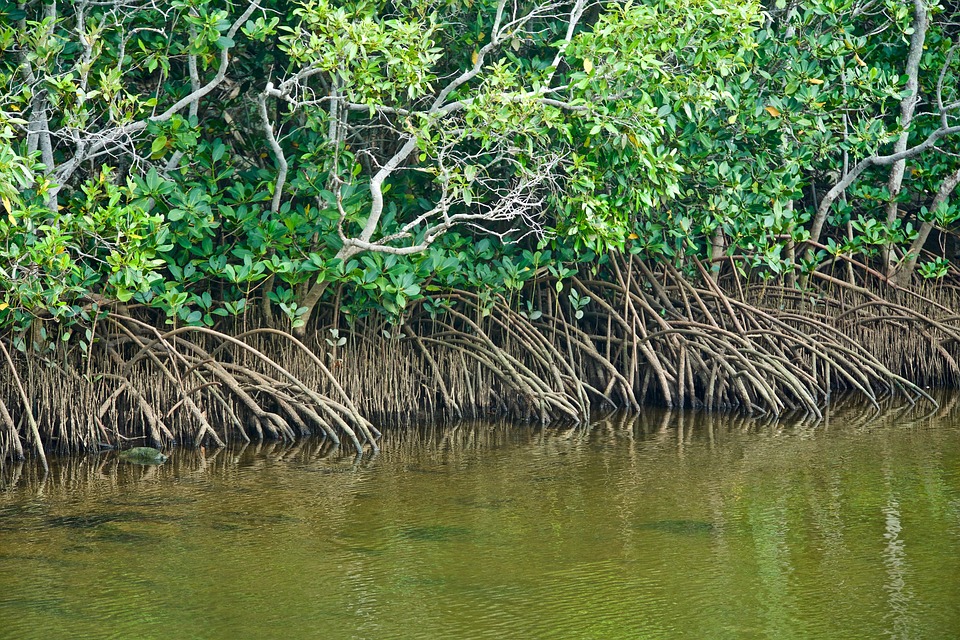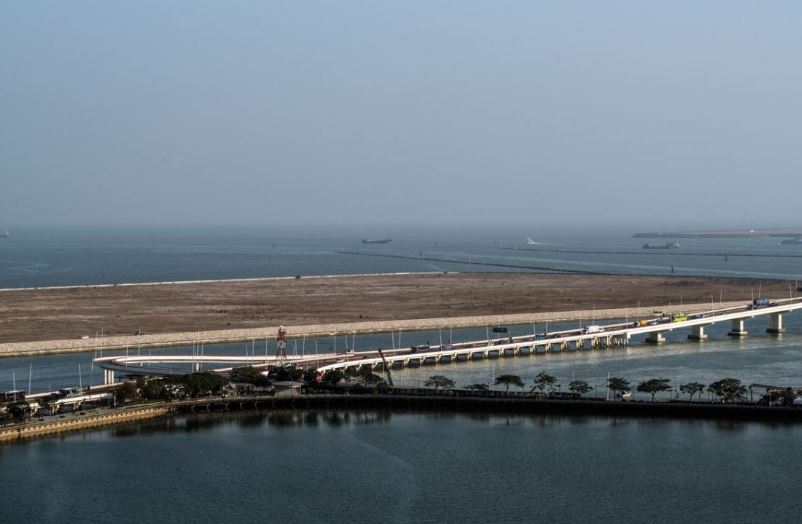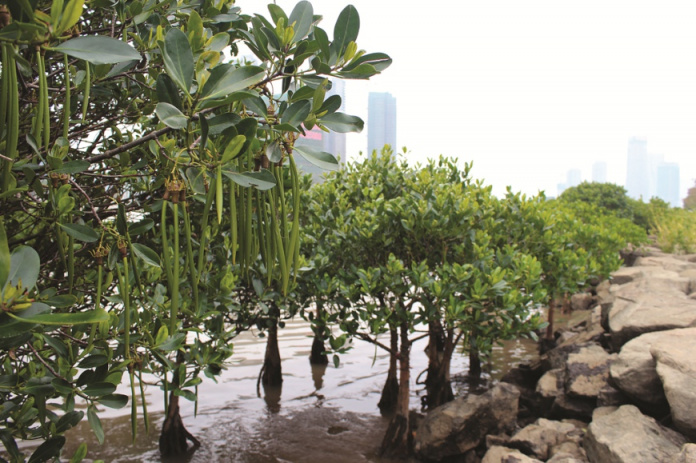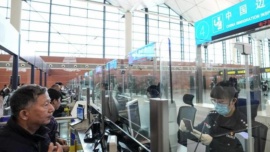A Macau-based study proves that wave reduction is influenced by mangrove density
Macau Business | August 2022 | Special Report | Hato’s “ghost” – 5 years on
A team of scientists from the University of Saint Joseph (USJ) recently concluded a project evaluating the wave attenuation capacity of mangroves through laboratory based wave flume experiments.
The team led by Karen Tagulao wanted “to assess the role of wetlands in climate change mitigation and adaption through carbon sequestration and other related measures” and “to investigate the efficiency of the local mangroves for coastal protection (via wave attenuation) using laboratory-based experiments.”
Finally, the research aimed “to promote the importance of wetlands for climate change mitigation and adaptation and mitigation through information campaigns and activities.
“Our preliminary results show that wave reduction is influenced by mangrove density and root/branch architecture,” Karen Tagulao tells Macau Business.
“This means that a denser or thicker mangrove forest would be needed for wave reduction to be effective,” she adds.
“We will continue this work with another project – another phase of the recently concluded one – this time to include in-situ (in the field) measurements along the coastal area where the mangroves are located. We will be installing some wave sensors in the field for this purpose,” Ms Tagulao explains. In their first phase they used 3D printed mangrove models and tested various species and densities (number of trees within a given area).
The findings of the team, which also includes Agata Dias, Marco Hio and Cristina Calheiros (all from USJ), are in line with previous studies undertaken outside Macau which show that “coastal wetlands like mangroves serve as natural coastal protection – they can significantly reduce damage from tropical storms, tsunamis and other similar hazards due to their ability to attenuate waves.”
Professor Tagulao points out that, based on a recent estimate, the median global storm protection value of wetlands amounts to around $447 billion/year and 4,620 lives saved/year.
“Aside from coastal protection, mangroves also provide many other ecosystem services: they are sites for recreation and science education, provide fishery resources, harness biodiversity and are responsible for phytoremediation of coastal water pollution, air quality regulation and, carbon sequestration (capture and storage of carbon), making them important nature-based solutions for climate change mitigation and adaptation. Because they are nature-based, they are more cost-effective than constructed levees or seawalls,” she adds.
Another recent study in China estimated that a gain of 1 km2 of wetlands corresponds to an average CNY 83.90 million decrease in damage from storms.
The problem, in the context of Macau, is how – and where – to create more coastal wetland zones? “It is feasible but requires careful evaluation of the sites before implementing any wetlands or mangrove planting project,” answers the researcher at USJ.
“The condition of the sites, especially the geomorphology (e.g. elevation) and hydrology (tidal patterns, period of inundation, etc.) must be properly understood first, with modifications or enhancement through eco-engineering made if necessary to allow planted mangroves to grow or to allow the natural recruitment of mangroves,” she adds.

“However, since not all coastal areas in Macau are suitable for mangroves, a combination of both green (mangroves) and grey (seawalls, etc.) might be necessary,” Ms Tagulao admits.
Professor Tagulao believes that mangroves, “especially seedlings, must also be protected from strong waves. They also must not drown, and that is why elevation is important. This kind of work is actually already being done at the restoration site in Taipa, but I believe there are still other potential sites at which to establish similar eco-zones.”
“Our preliminary results show that wave reduction is influenced by mangrove density and root/branch architecture” – Karen Tagulao
And it’s an issue not only in Macau but throughout the Greater Bay Area, an area experiencing massive and rapid urban development and interference from human activity.
This fact in itself complicates typhoon mitigation, according to the researcher, “because some areas of mitigation (e.g. coastal wetlands/mangrove areas) might be encroached upon or damaged by the infrastructures that come with development and urban expansion. However, I believe that a balance between nature and urban development can be achieved. For example, the coastal areas of reclaimed land or other suitable sites can be ecologically engineered to allow wetlands/mangroves to naturally recruit or colonize and survive.”
A good example of this, she says, is the establishment and maintenance of the Ecological Zones in Cotai (by the DSPA), in addition to the example already mentioned in Taipa (overseen by AIM).
But as was recently reported, the extent of the mangrove forests in Macau has been reduced to a third in the last three decades.
“There were 60 hectares in the 1990s, and now there are about 19, centred more on parts of Taipa, Cotai and Coloane. The pressure of urbanization destroyed them, but there is now a great effort by the authorities to reforest these areas with the collaboration of the University of São José,” environmental engineer Cristina Calheiros, of USJ, explained.
Reclamation, the dangers

The Pearl River Estuary is in the geometric centre of the Guangdong-Hong Kong-Macau Greater Bay Area, “which is one of the main battlefields for driving the high-quality development of China’s economy,” a mainland-based study states.
Its results show that from 1973 to 2021, the total length of the coastline of the Pearl River Estuary increased from 240.09 km to 416.00 km, while the total length of the continental coastline increased from 186.87 km to 246.21 km (however the amount of natural coastline within the continental coastline decreased from 136.91 km to 15.17 km).
In the same period, the total reclamation area of the Pearl River Estuary increased by 28,256.06 hectares.
Before 2012, the growth rate of reclamation was generally fast. Since 2012, according to Analysis on the Dynamics of Coastline and Reclamation in Pearl River Estuary in China for Nearly Last Half Century, “land reclamation in China has entered a period of reflection. With reclamation being strictly controlled in the new era, only reclamation projects with prior approval and major national projects have been guaranteed, making the average annual growth rate of coastline length and reclaimed areas in the region show a significant downward trend.”
Land reclamation in Macau has been the subject of another study, carried out in Beijing.
“The city of Macau has always been a typical example of reclamation. The increased room for a variety of land uses, especially for public facilities, brings opportunities for city development. However, some unexpected impacts have been discovered regarding land reclamation in Macau,” the study found.
The results of Evolution process of land reclamation in Macao and its impact on economy and ecology show that while the area of land reclaimed from the sea in Macau over the past 30 years “is huge, the area covered by vegetation has meanwhile decreased. The land reclaimed from the sea has been used to build casinos and transport facilities; these lands have provided explosive development to Macau’s economy in the past three decades.”
























